Notes from the MASS Zoom meeting on June 4, 2021
We had a quorum with Keith, Hank, Harry, Silvio, Phil and myself there for our 75 meeting and 11th one using Zoom. A missed communication kept Dean away and Beth was meeting at the same time with her analog space mission team that will be getting together in Poland this July. Keith did the honor of recording the meeting. I’m curious how our third recorded meeting will do with YouTube views. The first video had over 100 views and the second still hasn’t reached 50. Hard to believe that we have saturated the market already. Our next get-together might be in-person. I’m excited because we will be celebrating our 10th anniversary of MASS. It is hard to believe that our first meeting was on July 21, 2011. Time flies when you are having fun!
I warned the group that this meeting could go long. In fact, at the 2 1/2 hour mark, I had to lop off the “Space Tourism” topic. But I can save that topic for the next meeting. I’m like a kid in a candy store when it comes to picking stories and topics to share with the MASS group.
We then plunged into Introductory topics starting with a new book. I told everyone that Andy Weir has a new book out called, “Project Hail Mary“. I really enjoy his style of writing. He really researches the science behind his plot lines. His first book, “The Martian” has a great plot and his follow-up book about crime on the moon called “Artemis” was entertaining too. Without letting any spoilers out, all I can say is this book sounds interesting with the protagonist waking up in a hospital with total memory loss and the first part of the book dealing with how he recovers his identity and mission.
Our next Intro topic was revisiting the sunspot numbers for the last couple of months. The Sun is ramping up on its next 11 year Cycle 25 of sunspots. Most scientists have predicted a rather weak maximum of 115 sunspots in July 2025 but one rouge scientist is predicting more than twice that number. His prediction is a monthly max of 233. The most recent monthly numbers are May 2021 21.2 actual – 11.8 predicted and April 2021 24.5 actual – 10.3 predicated. The actuals, although higher, are quite close to the predicted graph. So, maybe the majority will be correct. The increased number of sunspots often is associated with more frequent and intense solar storms that can adversely affect planet Earth and the space around it. The radiation from the storms could cause problems for astronauts on space missions, especially if they are in spacesuits outside their capsule. According to Matthew Owens of the University of Reading, UK, NASA moon missions must launch by 2025 if they want to avoid the highest probability of solar storms. He says a large solar storm between the Apollo 16 (April 1972) and Apollo 17 (Dec 1972) could have killed an unprotected crew. I checked this time period and saw that in June 1972 the sunspot monthly number was 124.7. That month was when the Sun was coming out of a peak of 192.3 in Cycle 20. We had a brief discussion that some of the solar probes we have in space can give us an advanced warning that a solar storm will be rotating into Earth’s view. Light takes 8 minutes to reach us from the Sun. The heavier particles from the solar storm can come as early as 2 minutes after that light-time or as long as 3 or 4 days depending on their energy.
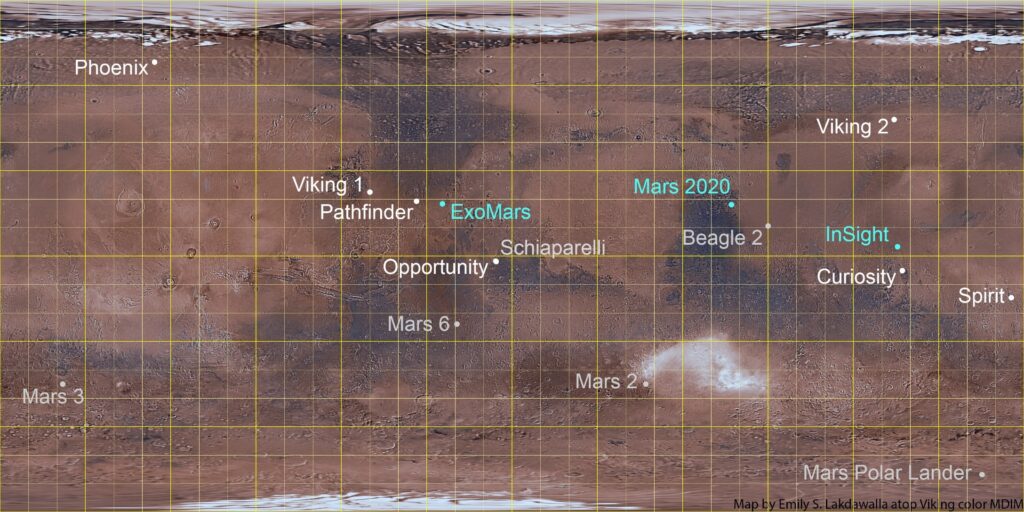
Next we talked about Mars missions starting with the Chinese rover, Zhurong, that had just landed in Utopia Planitia on May 14. The 530 lb (240 kg) solar powered rover is named after the Chinese fire god. I have to admit that I wasn’t eating any lucky peanuts during the time of landing. First, the Chinese were not that forthcoming in announcing what was happening and second China is not a good actor on the world stage. I don’t wish bad things on them, but the Chinese Communist Party has so many abuses of their own people, Hong Kong and Taiwan. It makes it hard to cheer for them. Here is a 3D map of the landing location. The rover carries panoramic and multispectral cameras and instruments to analyze the composition of rocks and investigate with ground-penetrating radar. It rolled out onto the surface on May 22. Here are some of the first pictures. Some of the delay in news from China, could be due to their lack of infrastructure around Mars. I heard they didn’t even announce their landing on Mars for 20 minutes. In their attempt to avoid a potentially embarrassing event, they don’t have the courage to cover it live.
We did a side-bar from Mars to cover some of the other accomplishments of China, including the launch of the first module, Tianhe (Harmony of the Heavens), of their space station. The module is 16.6m (55ft) long and 3.5m (11.5ft) diameter. It has a habitable volume of 50 m3 (1800 ft3), supports a crew of 3 and has 5 docking ports. The Tiangong-3 space station will be created with 11 launches and will have 3 major modules. Total weight will be 66 mt and will be completed in early 2022. The other two major modules are, Mengtian (Dreaming of the Heavens) and Wentian (Quest for the Heavens). A Long March 5 rocket, which has no second stage, was used to launch the module. This meant that the enormous rocket body also achieved orbit. See the next paragraph for the repercussions of that. The completed space station will have volume of 110m3 (3900 ft3), making it the 4th largest space station after ISS, Skylab and Mir. Shenzhou 12 launching in June 2021 will bring up a crew of 3. A 4th module will fly in formation but not be attached. This fourth module is call Xuntian and will house a telescope. The station is expected to have a 10 year life.
China has come a long way in 2.5 years, in Jan 2019 they landed on far side off moon, in Dec 2020 they returned a 4 lb sample from the moon, in May 2021 they successfully landed a rover on Mars on their first attempt, and in April 2021 they sent up their first module of their third space station. Wow!! And now they want to launch a broadband constellation of 13,000 satellites to compete with OneWeb from Europe and Starlink from SpaceX. China gets some criticism for not dealing with their 23 mt Long March 5B booster. Lucky this time that it landed in the Indian Ocean, but they are using the 5B rocket for numerous other space station launches. I was watching the satellite tracking on YouTube to see where it would deorbit. Chicago should have been ok with its 41.9 degrees north latitude. The booster orbit only got to 41.5 degrees. This lack of concern for human life and property is another reason China is a bad player on the world stage.
The issue of the United States cooperating with China comes up frequently. Rep. Don Beyer (D-VA), the new chair of the space subcommittee of the House Science, Space, and Technology Committee, told the Washington Space Business Roundtable today that he would like to be the sponsor of legislation to repeal the Wolf Amendment, which prevents NASA’s cooperation with China, but “when it’s justified,” not now. The situations in Taiwan, Hong Kong and “forced labor in concentration camps” preclude it in the short term, but “we also have to recognize they are a major player in space and someday in the future the opportunity to work with them for the benefit of all mankind is something we have to cling to.” China is welcoming international participation on the Tiangong-3 space station by working through the U.N. Office of Outer Space Affairs to find scientists who want to fly experiments. The European Space Agency astronauts have trained with Chinese taikonauts for potential future flights. The MASS group said that we should keep the Chinese at “arms distance” in cooperation in space until their leaders change their behavior. It would be nice for the Earth to show a common front in space missions because we could accomplish so much more with our resources. But, we are not at that place yet.
China and Russia have established a cooperation agreement and are asking other nations to join. They have invited other countries to join their ILRS (International Lunar Research Station). Working thru the United Nations, they plan to create a lunar base near the south pole of the moon that will focus on water and mineral resources. The United States response is the Artemis Accords that help define how countries should behave in the space and lunar endeavors. Recently South Korea and New Zealand have joined the previous members of the Accords, the United States, Australia, Canada, Japan, Luxembourg, Italy, the United Kingdom and the United Arab Emirates. Brazil might also soon join.
Back to Mars missions, the Ingenuity helicopter recently completed its 6th flight. Scott Manley did a nice job summarizing the flights so far. On the last flight it suffered from some instability issues that made it wobble by 20 degrees and it landed about 5m (16ft) from its target location. After the first 4 flights, Ingenuity accomplished all its tech demonstration goals, so NASA added another 30 days of operations support during which it could scout the best path for the Perseverance rover. Flights now will only be every couple of weeks. The 5th flight and 6th flights had it land at new airfields. During the 2nd flight on April 22, it rose to 5.2m (17 ft), traveled 2m (7 ft) east and back and remined airborne for 52 seconds. It also made 3 turns of 90 degrees, snapping pictures as it landed. The 4th flight had it travel 436 feet out and back.
Percy is celebrating its 104 sol today, Friday June 4. It has begun driving south. Commissioning is completed on all its instruments. Maybe the first core sample will be taken in July. It might take a few 100 sols to get to a rock outcrop about 2km (1.24 mi) away toward the southwest. After exploring the outcrop, it will head north and then west to the Jezero crater’s fossil river delta.
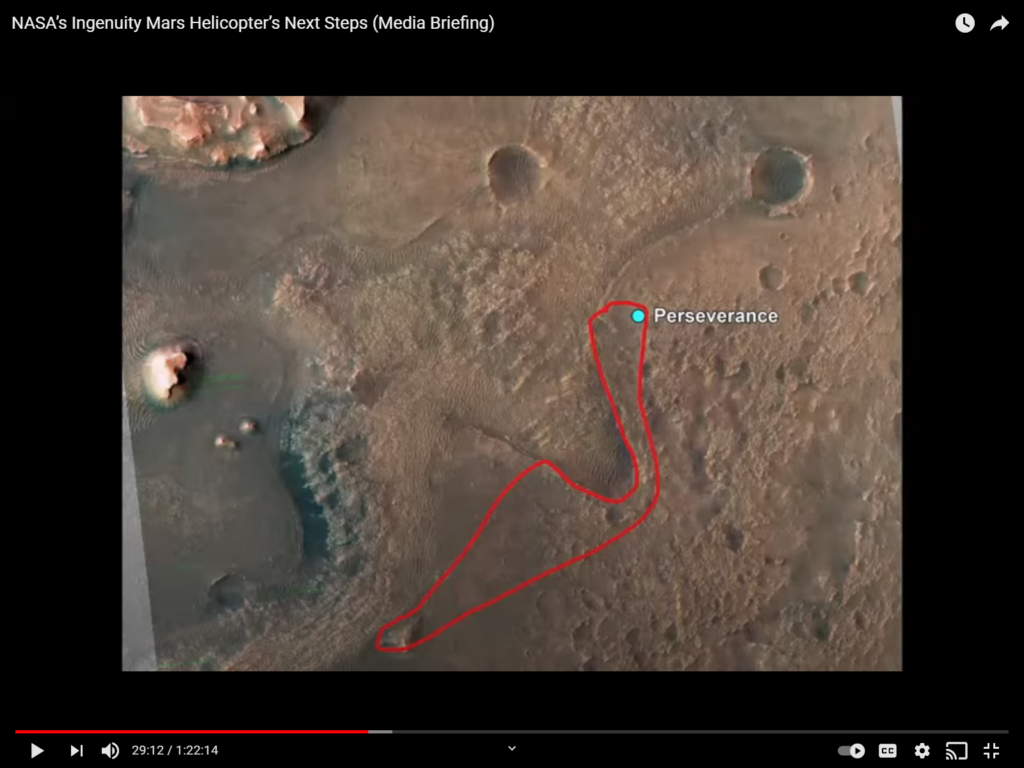
Our last Mars mission discussion was the Insight lander. Astrum has a nice video summarizing the mission so far. Dean is the lucky winner of several Mars candy bars for guessing the most pessimistic depth in the “mole burrowing” contest. Dust has Insight’s solar power down to just 27% of original value but mission has gotten a 2-year extension.
Moving on to SpaceX topics, the Starship SN15 successfully landed on May 5, 2021. Clouds hid the spacecraft after 20 seconds and no one captured the flip after the belly flop. A small fire was seen at the bottom of Starship on landing but the ground support extinguished it. SpaceX’s cameras froze frequently during the 10 km flight. SpaceX still has the SN16 prototype to fly but Musk announced that SN20/BN3 will do an orbital mission with Super Heavy rocket (BN3) landing 32 km offshore in the Gulf of Mexico and the Starship (SN20) doing a soft water landing in the Pacific Ocean off Hawaii after almost one orbit. As a side note, the US Air Force plans to spend $50 million this coming year to investigate Starship’s ability to land 100 mt of cargo anywhere in the world in one hour. To emphasize the enormous size of Starship, here is an artist’s rendering of it and the Orion capsule that will take 4 astronauts to the moon docked to the Lunar Gateway. The Gateway is the Artemis planned space station that will orbit the moon.
Launch of CREW2 Dragon capsule to the ISS occurred on April 23 with Guinguin, the zero-G indicator, the 7 inch toy was picked by the crew’s children. To give a rundown of previous Dragon zero-G indicators. DM-2 had the sequined dinosaur, Tremor, and the uncrewed DM-1 had plushy Earth, CREW1 had Grogu or Baby Yoda. The capsule for CREW2 was a reuse of the one from the DM2 mission, so Megan McArthur got to sit in the same seat her husband, Bob Behnken, was in. CREW2 docked to ISS on April 24. There was an 8-day overlap with CREW1. Hard to believe it has been over a year since DM2 launched on May 30, 2020 and reestablished the launching of US astronauts from American soil after an almost 10 year hiatus.
CREW1 landed at night off Florida’s coast. It came down, Sunday morning, May 2 at 3AM local time, off Panama City, FL. That time helped lessen pleasure boat interference. There also was a 2-mile exclusion zone that the Coast Guard maintained and NASA said no extraneous boats were around the capsule. There weren’t many real time shots of the astronauts exiting the capsule but latter video shows Mike Hopkins dancing when he was standing outside the capsule. Recovery of the capsule went very quickly. It only took 54 minutes to go from splashdown to the astronauts exiting the capsule. 167.25 days is the new record for an American capsule in space. This beats the old record of 84 days for the Apollo capsule used on the third and last Skylab mission. The capsule looks like a toasted marshmallow. Sea states were remarkably calm, only 1 ft waves and 3 mph winds. The Resilience capsule will now be refurbished and outfitted with a viewing dome window for the 3-day Inspiration4 private mission in September 2021.
The CREW3 crew is now complete with the announcement of Kayla Barron. Is it just me, or do the astronauts look young enough to be only in high school? The mission will have the youngest and oldest long duration astronauts in Kayla Barron (age 34) and Tom Marshburn (age 61). The 4th seat on the mission was being withheld to see if Russia would send a cosmonaut, they didn’t. I think the whinny Russians are still upset that we aren’t paying $85 million a pop to fly our astronauts on Soyuz. The US wants to exchange one seat on Dragon for a cosmonaut for one seat on Soyuz for one of our astronauts. That way, there is always one person from each country to maintain the two sections of the ISS in case launches don’t occur regularly. CREW3 is scheduled to launch Oct 23, 2021.
The CRS-22 cargo Dragon launched June 3, 2021. It contains 3000 tardigrades, numerous baby squid to study their interaction with bacteria, a middle school 2U cubesat to study wild fires and the first pair of new roll-out solar arrays. These roll-out arrays are enormous and the cargo mission patch is cool. The Dragon capsule contained 7300 lbs of cargo (4300 lb pressurized and 3000 lbs of solar arrays in trunk). The solar arrays will be 60 ft long when unrolled.
CRS-22 was the 17th launch for SpaceX in 2021 and the 86th time the first stage booster was recovered. It was the 120th launch of a Falcon9 rocket. On a May 9 launch of Starlink satellites, SpaceX successfully launched and recovered a Falcon9 for the 10th time. The first Falcon 9 launch was on June 4, 2010. 11 years ago today.
Turning now to NASA stories, President Biden has just celebrated his first 100 days in office with this short NASA video.
Bill Nelson, 78, was confirmed by an unanimous vote as NASA Administrator. Unanimous votes are a rarity with the likes of Ted Cruz in the mix. I recently learned that Bill Nelson’s Shuttle flight came back from orbit just 10 days before the Challenger exploded on liftoff. He gave a great “State of NASA” speech. There even was an appearance by William Shatner in the video making an emotional presentation. Nelson also made a great 6-minute address to the NASA workforce.
The new NASA Presidential Budget Request (PBR) for FY 2022 was just released. The $24.8 billion for FY 2022 that is recommended is a 7% increase over the current budget of $23.3 billion this fiscal year which ends on September 30. There is strong emphasis on science. $7.9 billion is for science including Earth science and exploration of the moon and planets. That is a 9% increase. $137.8 million is for a series of 5 satellites for the new Earth System Observatory which will study our planet in depth. $653 million is for the Mars Sample Return mission in 2026. $1.195 billion is to develop the Human Landing System (HLS). This amount would support a unmanned demonstration landing mission, followed by a manned landing with Starship as early as 2024. Congress might try some questionable modifications to the “Endless Frontier Act” to tap an additional $10 billion over next 4 years for a second lander, probably Blue Origin. But this maneuver is getting a lot of criticism. SOFIA, the 747 plane with an infrared telescope, is recommended for cancellation. The cost of this program is $85 million a year and is not yielding that much new science. Orion, SLS, and ground systems funding is flat. Here is Casey Dreier of the Planetary Society take on the PBR and a nice table comparing 2021 amounts and the 2022 requests.
The Boeing Starliner capsule is scheduled to repeat its unmanned 4-8 day mission to dock with ISS called OFT-2. Launch is scheduled for July 30. Starliner is costing NASA $90 million per seat. The Russian Soyuz cost was $85 million and Crew Dragon seats only cost $55 million. Maybe it’s time to cut bait with Starliner and pursue Dreamchaser as the alternate US manned craft to ISS. We need something to replace Soyuz reboost capability on ISS any way and Dreamchaser will do that. We might have the much delayed and expensive Starliner project to thank for NASA’s decision to make Starship from SpaceX its sole HLS choice. Thanks Boeing. A cargo version of Dreamchaser is still being funded by NASA and should be launching to the ISS starting in 2022. Hopefully, Sierra Nevada will go the extra step and upgrade it to carry people too.
NASA has selected two new Venus missions. First is DaVinci+ (Deep Atmosphere Venus Investigation of Noble gases, Chemistry and Imagining Plus). It will include both an atmospheric probe landing on the surface and an orbiter. It will launch in 2030. The lander will take about an hour to descend thru the atmosphere. Eventually it will discard the chute and hit the surface at 20-25 mph. It might not survive the impact, but if it does, it could send data for a few tens of minutes before it melts. It consists of a titanium pressure vessel with a sapphire window for observing. It will be able to detect phosphene (a potential bio-signature of bacterial life in the clouds of Venus) and might determine if Venus ever had oceans. The other mission, Veritas (Venus Emissivity, Radio Science, In SAR, Topography and Spectroscopy) will map Venus’ surface with 100x improved resolution and determine geologic history. It is launching in 2028. It will be the first US Venus probe in 30 years. The 1994 Magellan was last US mission. Japan and ESA have sent missions to Venus more recently. Both projects are Discovery class missions and are capped at $450 million excluding launch vehicle and mission operations costs. Lunar Reconnaissance Orbiter (LRO) and Mars Insight were both Discovery programs. The upcoming Lucy and Psyche asteroid missions are also Discovery missions. The short Venus 101 video gives you the low down on characteristics of the planet. Venus has a temperature of >900 degrees F, sulfuric acid in its clouds, and a thick atmosphere 90x earth’s atmospheric density. It has a 243 day backward rotation rate and because Venus takes 225 days to revolve around the sun, the day-night cycle lasts 117 days. It is weird that Venus’ sidereal day (rotation relative to the stars) is longer than the Venusian year. Venus’ orbit is almost a perfect circle and the axial tilt is just 3 degrees, so it has no noticeable seasons. The longest functioning Russian probe lasted 127 minutes on surface.
On 4/29/21, Apollo 11 astronaut, Mike Collins, died at age 90. This leaves only Buzz from Apollo 11. Of the 24 men who circled or landed on the moon, only 10 are still alive. The youngest is 85. Will any of them make to when we return people back to the moon’s surface?
The only HLS award from NASA went to Starship from SpaceX. No one saw that coming. SpaceX was considered third in a race of three designs, Blue Moon from Blue Origin and other big aerospace contractors, Alpaca from Dynetics and Starship from SpaceX. NASA’s $2.9 billion HLS award assures SpaceX the ability to develop, test and send 2 missions to the lunar surface, the first unmanned, the second with people. Blue Origin’s proposal was the most conventional with a 3-stage landing design but was not reusable. Dynetics was more innovative and reusable but was unambitious. It would allow only a few astronauts to the moon with just a little cargo. In contrast, SpaceX Starship is huge, making it oversized for the lunar mission and it has full reusability. NASA decision is risky but has the potential for a game changing shift in capability. SLS costs $2 billion per launch partly because the entire rocket is ditched in the ocean. Now with Starship, NASA can get 100 tons of cargo to the moon with a rocket that can be reused dozens of times. Musk’s vision of economies of scale may become the way to change an industry. NASA’s decision might have been a matter of economics but it has the potential to change the economies of space. Musk also says the 2024 landing is still possible. I think the critical item in meeting this time critical goal, is NASA’s ability to launch SLS for the 3rd time (Artemis 3) by then. The astronauts that Starship will take down to the moon’s surface, will launch on SLS and travel to and from the lunar orbit on the Orion capsule. I’m not sure we should attempt docking the Orion to Starship in lunar orbit before the US has a functioning Lunar Gateway orbiting the moon.

In Ars Technica, Eric Berger notes that Starship is 50 m high compared to the Apollo Lunar Module which is only 7 m high. By betting on Starship, NASA gets a sustainable lunar program. There could be hundreds of astronauts going to the moon with 100s of tons of cargo and supplies. For a year, the 3 HLS companies worked with NASA to fine-tune their designs. Starship is massively oversized to take 2 or 4 astronauts to the moon’s surface but it is the only one fully reusable. Starship is the most technically demanding because of its size and aspirations. SpaceX must learn how to land Starship on the Moon and Earth, conduct missions to the moon and develop refueling technology for methane and liquid oxygen in LEO. SpaceX has shown that its engineers are the best in the world in designing, building and flying new and innovative rockets. Falcon9, Falcon Heavy and Crew Dragon all proved this. With this announcement, humans landing on Mars seems more doable in a decade. SLS will launch 95 mt into LEO but at a cost of $2 billion. Starship and Super Heavy will lift a similar 100 mt but can be built in a month and reused. Starship might only cost $2 million per launch. Imagine if you could launch 100 mt every 2 weeks. NASA may be putting the SLS out of business by funding Starship development. Maybe NASA is becoming too dependent on SpaceX. SpaceX has damaged the commercial launch industries of Europe, Russia and Japan with its Falcon 9 and Falcon Heavy rockets. This HLS decision could hurt international cooperation because other nations would fear US dominance. Ultimately physics will win out. If SpaceX can make Starship work, NASA’s other options will look ridiculous in comparison. NASA’s decision has improved the odds of Starship’s success
There is a new YouTuber called Apogee that has done some interesting videos on HLS & Artemis. Here is a link to his “Why Starship won the HLS award”.
Blue Origin and Dynetics have lodged protests that have frozen the HLS money for SpaceX until August. Senator Maria Cantwell (WA-D), is adding a clause in the Endless Frontier Act, legislation which deals primarily with keeping the US competitive with China, to make $10 billion available for a second moon lander. The bill also requires NASA to continue development of the Exploration Upper Stage for SLS. It also says NASA must use this more powerful second stage on the 3rd launch of the rocket. NASA has said it doesn’t need this increased capability that soon. This will place another $10 billion unfunded burden on NASA possibly stealing money from science projects over 5 years. That second stage development clause comes from Roger Wicker (MS-R) whose Stennis testing facility will stay active. Congress can be all about “pork” at times. I hate it when politicians design rockets and space missions.
It provides good theater with the interchange between Musk & Bezos about the HLS awards. Engineering Today did a nice job showing the back and forth banter between the two CEOs.
Our last couple of topics dealt with asteroids and the James Webb Space Telescope (JWST).
First topic was that the Osiris-Rex probe left the asteroid Bennu on Monday, May 10th . It is bringing back a half to one pound sample (200-400 grams) of 4.5 billion year old rocks and will land in the Utah desert in September 2023. At 500m, Bennu is the smallest object ever orbited. It is a Near Earth Object (NEO) and has a 1.2 year orbital period that is inclined 5 degrees to Earth’s orbital plane. Every 6 years, it makes a close approach to Earth. Late in the 2100s it could impact earth. There is a 1 in 2700 chance of impact during the years 2175 to 2199. The Yarkovsky effect causes Bennu to spiral in toward the sun. This effect is when solar radiation is re-emitted by the surface of the asteroid and causes its orbital speed to decrease. Bennu spirals in toward the Sun because its rotation is opposite its orbital motion. It orbits counter-clockwise but rotates clockwise. A 500m sized object like Bennu could take out a continent on earth (1200 megaton explosion). Asteroids have been the darling of recently commissioned NASA missions. Lucy will launch in October 2021 and fly past 7 Trojan asteroids in Jupiter’s orbit. Trojans are asteroids in the L4 and L5 Lagrange points that are 60 degrees ahead and behind the planet in its orbit. The Dart mission will launch in November 2021 and impact the moon (Dimorphos) of the asteroid, Didymos. Finally, Psyche will launch in early 2022 to visit what is believed to be the metallic core of a much larger asteroid. The object is almost totally composed of metal. Its street value in metals would be $10 quintillion.
Our final topic was that on May 11, the last opening of JWST occurred at the Northrup Grumman facility in California. Now the telescope will be folded back up for the last time and shipped by boat to French Guiana in the northern part of South America. The telescope is too large for a C5 plane and even if it fit into an Antonov An-225 from Russia, there are 7 bridges between the airfield and the launch site that could not take the load of the telescope. It will take 12-14 days to reach South America by ship. Already 200 scientists are picking the first year’s worth of observations. It will take JWST up to 6 months to travel to a Lagrange point on the far side of the moon and unfold into its final configuration. JWST has no cameras to show this deployment because running a set of wires thru the sun shield would compromise the required thermal isolation of telescope. The telescope was to launch on Halloween, October 31, 2021, but an issue with vibrations when the fairings of the Ariane 5 rocket are released has come up on the last two launches. When Ariane 5 was picked for JWST, it was the most reliable rocket ever. Launch will probably be delayed until mid-November 2021 so that two Ariane 5 launches can demonstrate that the fairing issue is resolved. Ariane 5 has been grounded since August 2020 to come up with a solution for the fairing vibration.
To understand a little why astronomers are so excited about the JWST, currently the most distant galaxy ever seen has a redshift of z=11. This means an emission line normally at 100 nm wavelength would appear to be shifted to a wavelength 12x longer or 1200 nm. The equation for redshift(Z) is Z = (wavelength(observed) – wavelength(at rest)/wavelength(at rest). This means that most distant galaxy is seen 450 million years after the Big Bang or 13.4 billion light years away. Because of its infrared capability, JWST might be able to see galaxies with z of 12, 13 or 14 which is only 150 million years after the Big Bang. Dr. Becky on Youtube has a good video called “Is JWST worth the hype?”.
Time made me cut the last set of topics about “Space Tourism”. Even with that abbreviation, we closed the meeting at 10 PM. Thanks to those that stuck thru to the bitter end.
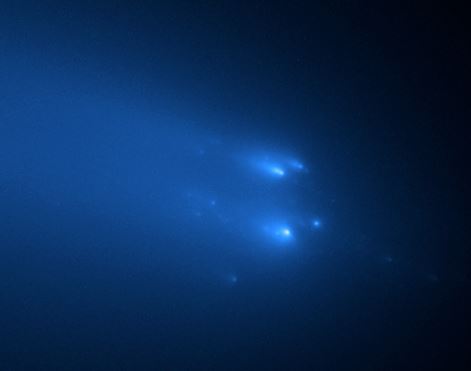
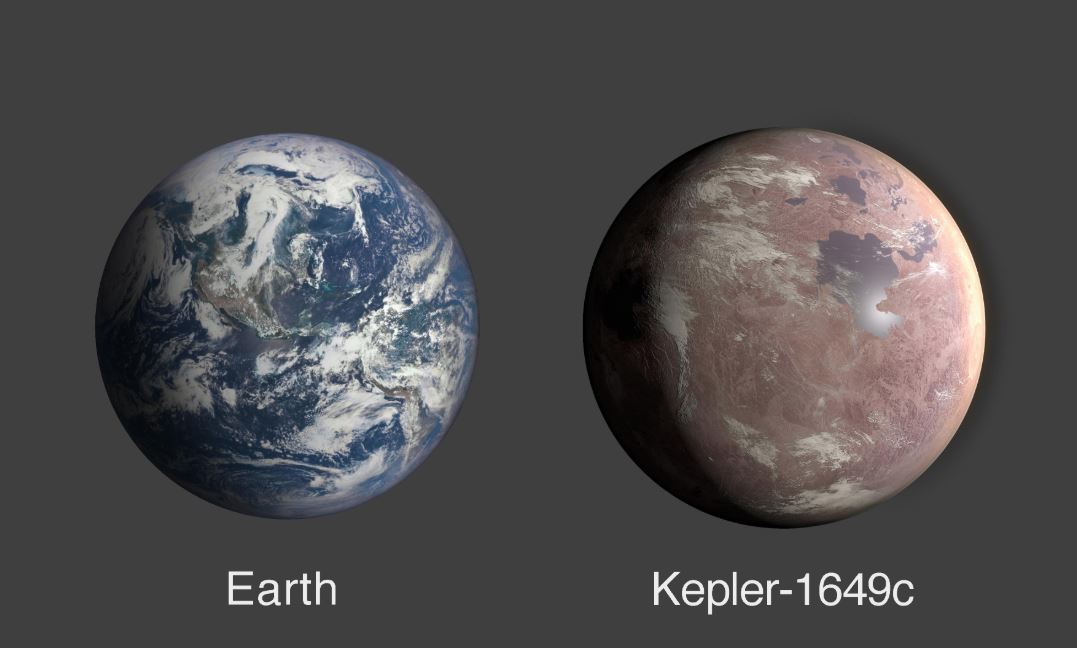
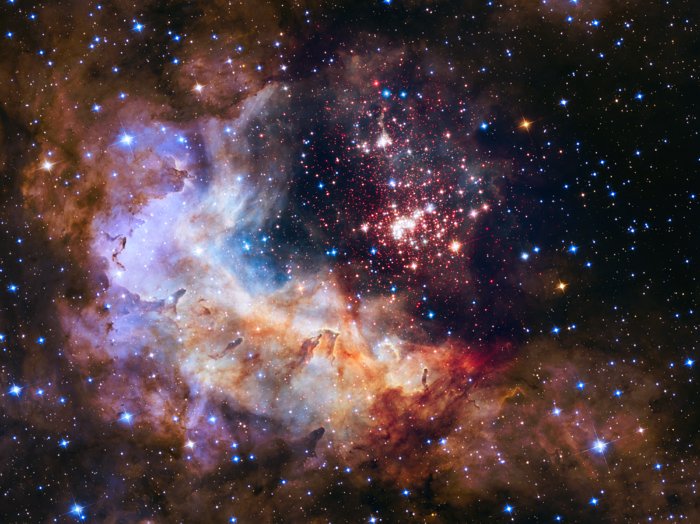
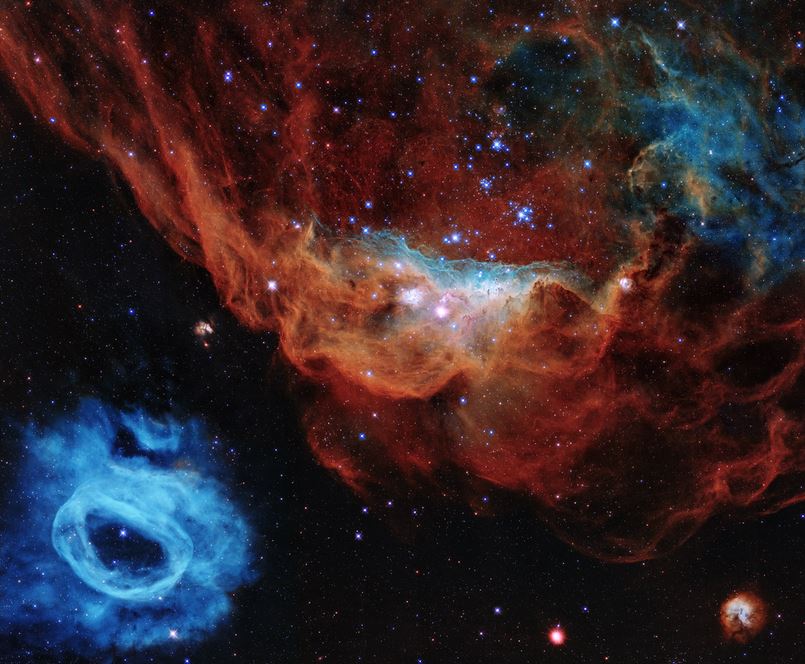

Recent Comments